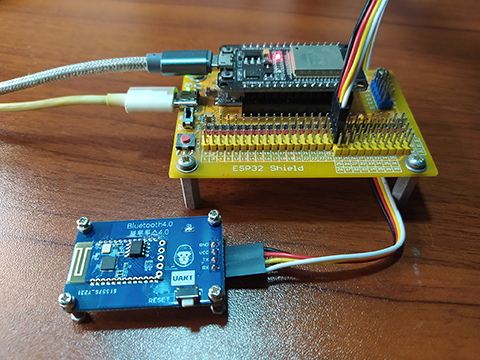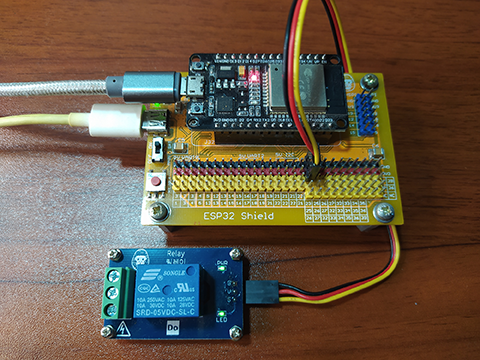Tutorial: ESP32 Web Server | Control something through ESP32 WiFi in Station Mode
ESP32 has a WIFI capability where we can take advantage for controlling anything remotely
In this tutorial we will learn how to use ESP32 to host a website for controlling anything lets say turning ON or OFF of the light at home. In this video, we will just use LEDs for demonstration. If you decided to use it in the actual application, you may connect a relay instead of the LED.
Circuit Diagram:
Video Demonstration:
If you have any question, please write it in the comment box so I may try it to the best I can do. Please LIKE, SHARE, and SUBSCRIBE.
Thank you and have a good day.
Source Code:
/* Simple ESP32 Web Server
* The ESP32 Wifi is configured as station mode.
*
*/
#include <WiFi.h>
#define BLUE_LED 25
#define GREEN_LED 26
#define RED_LED 27
// Create the objects for server and client
WiFiServer server(80);
WiFiClient client;
const char* ssid = "your ssid";
const char* password = "your password";
// Create the global variable
String http;
String bluLedState = "off";
String grnLedState = "off";
String redLedState = "off";
void setup() {
Serial.begin(115200);
pinMode(BLUE_LED, OUTPUT);
pinMode(GREEN_LED, OUTPUT);
pinMode(RED_LED, OUTPUT);
digitalWrite(BLUE_LED, LOW);
digitalWrite(GREEN_LED, LOW);
digitalWrite(RED_LED, LOW);
Serial.print("Connecting to ");
Serial.println(ssid);
// Connect the Wifi to the router
WiFi.begin(ssid, password);
while (WiFi.status() != WL_CONNECTED) {
delay(500);
Serial.print(".");
}
Serial.println("");
Serial.println("WiFi connected.");
Serial.println("IP address: ");
Serial.println(WiFi.localIP());
// Start our ESP32 server
server.begin();
}
void loop(){
if ( client = server.available() ) { // Checks if a new client tries to connect to our server
Serial.println("New Client.");
String clientData = "";
while ( client.connected() ) { // Wait until the client finish sending HTTP request
if ( client.available() ) { // If there is a data,
char c = client.read(); // read one character
http += c; // then parse it
Serial.write(c);
if (c == 'n') { // If the character is carriage return,
// it means end of http request from client
if (clientData.length() == 0) { // Now that the clientData is cleared,
sendResponse(); // perform the necessary action
updateLED();
updateWebpage();
break;
} else {
clientData = ""; // First, clear the clientData
}
} else if (c != 'r') { // Or if the character is NOT new line
clientData += c; // store the character to the clientData variable
}
}
}
http = "";
client.stop(); // Disconnect the client.
Serial.println("Client disconnected.");
Serial.println("");
}
}
void sendResponse() {
// Send the HTTP response headers
client.println("HTTP/1.1 200 OK");
client.println("Content-type:text/html");
client.println("Connection: close");
client.println();
}
void updateWebpage() {
// In here we will display / update the webpage by sending the HTML
// to the connected client
// In order for us to use the HTTP GET functionality,
// the HTML hyperlinks or href is use in the buttons.
// So that, when you press the buttons, it will send a request to the
// web server with the href links by which our ESP32 web server will
// be check using HTTP GET and execute the equivalent action
// Send the whole HTML
client.println("<!DOCTYPE html><html>");
client.println("<head>");
client.println("<title>ESP32 WiFi Station</title>");
client.println("</head>");
// Web Page Heading
client.println("<body><h1>Simple ESP32 Web Server</h1>");
// Display buttons for Blue LED
client.println("<p>1. Blue LED is " + bluLedState + "</p>");
if (bluLedState == "off") {
client.println("<p><a href="/BLUE_LED/on"><button>Turn ON</button></a></p>");
} else {
client.println("<p><a href="/BLUE_LED/off"><button>Turn OFF</button></a></p>");
}
client.print("<hr>");
// Display buttons for Green LED
client.println("<p>2. Green LED is " + grnLedState + "</p>");
if (grnLedState == "off") {
client.println("<p><a href="/GREEN_LED/on"><button>Turn ON</button></a></p>");
} else {
client.println("<p><a href="/GREEN_LED/off"><button>Turn OFF</button></a></p>");
}
client.print("<hr>");
// Display buttons for Red LED
client.println("<p>3. Red LED is " + redLedState + "</p>");
if (redLedState == "off") {
client.println("<p><a href="/RED_LED/on"><button>Turn ON</button></a></p>");
} else {
client.println("<p><a href="/RED_LED/off"><button>Turn OFF</button></a></p>");
}
client.println("</body></html>");
client.println();
}
void updateLED() {
// In here we will check the HTTP request of the connected client
// using the HTTP GET function,
// Then turns the LED on / off according to the HTTP request
if (http.indexOf("GET /BLUE_LED/on") >= 0) {
Serial.println("Blue LED on");
bluLedState = "on";
digitalWrite(BLUE_LED, HIGH);
} else if (http.indexOf("GET /BLUE_LED/off") >= 0) {
Serial.println("Blue LED off");
bluLedState = "off";
digitalWrite(BLUE_LED, LOW);
} else if (http.indexOf("GET /GREEN_LED/on") >= 0) {
Serial.println("Green LED on");
grnLedState = "on";
digitalWrite(GREEN_LED, HIGH);
} else if (http.indexOf("GET /GREEN_LED/off") >= 0) {
Serial.println("Green LED off");
grnLedState = "off";
digitalWrite(GREEN_LED, LOW);
} else if (http.indexOf("GET /RED_LED/on") >= 0) {
Serial.println("Red LED on");
redLedState = "on";
digitalWrite(RED_LED, HIGH);
} else if (http.indexOf("GET /RED_LED/off") >= 0) {
Serial.println("Red LED off");
redLedState = "off";
digitalWrite(RED_LED, LOW);
}
}


